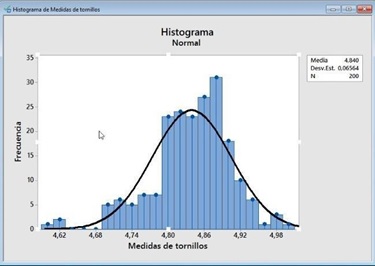Quality Control Analysis to Detect Defects in Drywall Fastener Screws
DOI:
https://doi.org/10.17981/bilo.5.1.2023.02Palabras clave:
Drywall screws, Screw defects, Screw manufacturing, Screw qualityResumen
Screws are pieces designed to join two or more elements, they are composed of three parts that are thread, neck, and head. Depending on the type of material they are made of their size and functionality can acquire different characteristics. This article describes the way in which a sample of 200 2-inch screws used for drywall were evaluated to detect potential failures in their manufacturing, through the application of quality tools, with which the main factors that intervene to achieve the best quality of these products were determined. In addition, the study of a real case allowed us to demonstrate feasible improvements that can be applied not only in a certain area, but in the whole industry, since the quality of a product also determines the potential growth of a company. The results obtained showed the degree of affectation of each defect, being advisable for the company to focus on bent screws, screws with deformed tips and screws with incorrect measurements, as these represent greater losses. In conclusion, in the industry it is necessary to use and manage tools to increase the productivity and quality of the processes, thus having a significant impact on all areas of production, achieving the best possible final product.
Descargas
Citas
E. Yildiz and F. Wörgötter, "Dcnn-based screw detection for automated disassembly processes," in 2019 15th International Conference on Signal-Image Technology & Internet-Based Systems (SITIS), 2019.
H. Gutiérrez Pulido, Calidad Total y Productividad, Mexico: McGraw-Hill/Interamericana Editores,S.A., 2010.
U. Gabler, I. Osterreicher, P. Bosk and C. Nowak, "Zero defect manufacturing as a challenge for advanced failure analysis", in 2007 IEEE/SEMI Advanced Semiconductor Manufacturing Conference, 2007.
J. Priede, "Implementation of Quality Management System ISO 9001 in the World and Its Strategic Necessity," Procedia- Social and Behavioral Sciences, vol. 58, pp. 1466-1475, 2012.
J. Breitenbach, I. Eckert, V. Mahal, H. Baumgartl, and R. Buettner, "Automated Defect Detection of Screws in the Manufacturing Industry Using Convolutional Neural Networks," from Proceedings of the 55th Hawaii International Conference on System Sciences, 2022.
S.-H. Park, K.-H. Lee, J.-S. Park and Y.-S. Shin, "Deep Learning-Based Defect Detection for Sustainable Smart Manufacturing," Sustainability, vol. 14, no. 5, p. 2697, 2022.
J. Lehr, M. Schlüter, and J. Krüger, "Classification of Similar Objects of Different Sizes Using a Reference Object by Means of Convolutional Neural Networks," from 24th IEEE International Conference on Emerging Technologies and Factory Automation (ETFA), 2019.
K. HangHong, X. JuinMing, Y. ChaoTang, and Y. JunJuh, "Screw defect detection system based on AI image recognition technology," from 2020 International Symposium on Computer, Consumer and Control (IS3C), 2020.
M. Ferhat, M. Ritou, P. Leray and N. Le-Du, "Incremental discovery of new defects: application to screwing process monitoring," Elsevier, vol. 70, no. 1, pp. 369-372, 2021.
Y. H. Hung, "Developing an Anomaly Detection System for Automatic Defective Products' Inspection," Processes, vol. 10, no. 8, p. 1476, 2022.
P. Bergmann, M. Fauser, D. Sattlegger, and C. Steger, "MVTec AD--A comprehensive real-world dataset for unsupervised anomaly detection," from Proceedings of the IEEE/CVF conference on computer vision and pattern recognition, 2019.
J. Yang, S. Li, Z. Wang, and G. Yang, "Real-Time Tiny Part Defect Detection System in Manufacturing Using Deep Learning," Opt. IEEE Access, vol. 7, pp. 89278-89291, 2019.
T. Wang, Y. Chen, M. Qiao, and H. Snoussi , "A fast and robust convolutional neural network-based defect detection model in product quality control," The International Journal of Advanced Manufacturing Technology, vol. 94, no. 9, pp. 3465-3471, 2018.
L. Song, X. Li, Y. Yang, X. Zhu, Q. Guo, and H. Yang, "Detection of Micro-Defects on Metal Screw Surfaces Based on Deep Convolutional Neural Networks," Sensors, vol. 18, no. 11, pp. 3709-3723, 2018.
M. Pour, H. Hatefnia, A. Dorieh, M. V. Kiamahalleh and Y. M. Afrouzi. M. Afrouzi, "Research on Medium density
fiberboard (MDF) behavior against screw axial withdrawal: Impact of density and operational variables," Elsevier, vol. 39, pp. 194-206, 2022.
H. Ukida, "Visual defect inspection of rotating screw heads," from SICE Annual Conference 2007, 2007.
S. Bansal, S. L. Tyagi, and V. K. Verma, "Performance Modeling and Availability Analysis of Screw Manufacturing Plant,"Materials Today: Proceedings, vol. 57, pp. 1985-1988, 2022.
P. Martinez, M. Al-Hussein and R. Ahmad, "Intelligent vision-based online inspection system of screw-fastening operations in light-gauge steel frame manufacturing," The International Journal of Advanced Manufacturing Technology, vol. 109, no. 3, pp. 645-657, 2020.
S. Yang, H. Liu, Y. Zhang, T. Arndt, C. Hofmann, B. Häfner, and G. Lanza, "A Data-Driven Approach for Quality Analytics of Screwing Processes in a Global Learning Factory," Elsevier, vol. 45, pp. 454-459, 2020.
S. C. Kiong, L. Y. Lee, S. H. Chong, M. A. Azlan, and N. H. Muhd-Nor, "Decision making with the analytical hierarchy process (AHP) for material selection in screw manufacturing for minimizing environmental impacts," from 3rd International Conference on Environmental Impact of Screw Manufacturing in the United States of America, 3rd International Conference on Environmental Impact of Screw Manufacturing in the United States of America, New York, USA. on Mechanical and Manufacturing Engineering, 2013.


 English
English
 Español (España)
Español (España)
